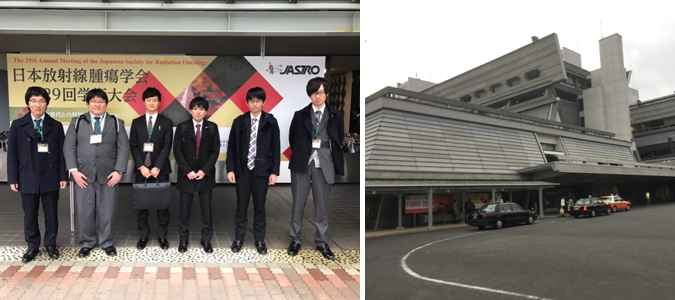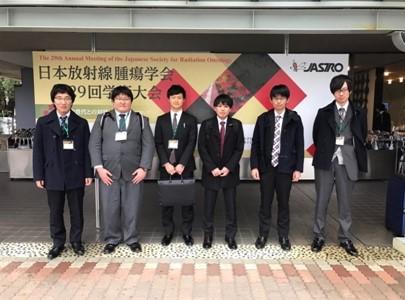2016.11.25-11.27:JASTRO 29 Annual meeting
The 29th Annual Meeting of the Japanese Society for Radiation Oncology (JASTRO) held in Kyoto International Conference Center, Kyoto.
Dr. Kadoya(Assistant professor), Mr. Abe(D4), Mr. Sugawara(D3), Mr. Kanai(D2), Mr. Nakajima(D1), Mr. Takayama(M2), Mr. Abe(M1), Mr. Ieko(M1), Mr. Ikeda(M1) and Mr. Kon(M1) have attended it for oral presentation. Ms. Chiba (Assistant) and Mr. Miyasaka(M2) have attended it in Kyoto International Conference Center, Kyoto, Japan on November 25-27, 2016.
■Date: 11.25-27,2016
■Venue: Kyoto International Conference Center, Kyoto, Japan
■Conference name:The 29th Annual Meeting of the Japanese Society for Radiation Oncology

Yshio Kon(M1)
We are pleased to report that we participated in the 29th Annual Meeting of the Japanese Society of Radiation Oncology (JASTRO) held on November 25-27, 2016, together with Dr. Kadoya, Mr. Chiba, Mr. Abe(D4), Mr. Sugawara(D3), Mr. Kanai(D2), Mr. Nakajima(D1), Mr. Takayama(M2), Mr. Miyasaka(M2), Mr. Abe(M1), Mr. Ieko(M1), Mr. Ikeda(M1), Mr. Kon(M1).
The venue this time was Kyoto International Conference Center in Kyoto. As the conference website says, the autumn leaves are beautiful in Kyoto at this time of year, and at the luncheon seminar I attended, a dish was served that looked like a maple tree in autumn.
The main theme of the conference was “Conversation with the Next Generation-Toward Higher Goals. The main theme was “Conversation with the Next Generation-Toward Higher Goals. As I myself have just started my studies, I participated in this conference for the first time with the goal of growing as much as possible.
My presentation was titled “Validation of commercially available 3D EPID in-vivo dosimetry software
for a prostate VMAT plan”. Since it is almost impossible to measure the actual dose in the body irradiated to a patient, I believe that accurate reconstruction of the dose at the time of treatment would be effective to enhance the effectiveness of the treatment. Therefore, there is a reconstruction method that uses both EPID images and log-files, which are the information at the time of actual irradiation, as a method of reconstructing the irradiated 3D dose. In the Q&A session, I was able to notice items that I had not considered that might affect the results due to the appropriate opinions of the professors, and I also had the opportunity to hear from professors using the same system and discuss questions that I have in the process of data acquisition and analysis, It was a very meaningful time for me. I hope to continue to present the results of my research at such conferences in the future, as this dose reconstruction method is a new technique that has hardly been reported at this conference.
My fellow first-year master’s students also gave oral presentations for the first time, but they presented their research results and had lively discussions with the professors.
In the luncheon seminar, I was personally interested in the introduction of the next generation 3D water phantom. This is a water phantom that is automatically set up and requires almost no additional devices, and it has the potential to make the QA currently being performed at this hospital even easier.
Finally, I gained valuable experience and knowledge for my future research at JASTRO. I would like to take this opportunity to thank everyone who gave me this opportunity. Thank you very much.

Tohoku University Medical Physics Member
